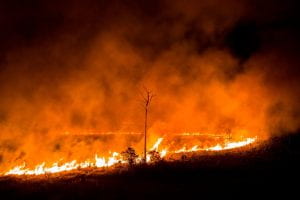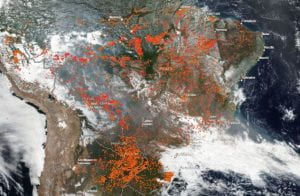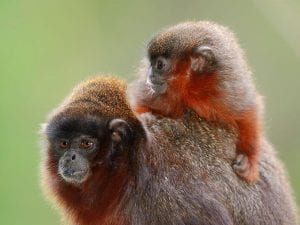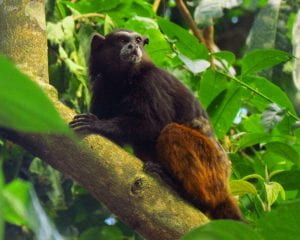Fires are Raging in the Amazon, Here’s What You Need to Know
The Amazon Rainforest, one of the most vital and significant natural areas on the planet, is on fire. As it burns, it endangers the lives of many plants and animals endemic to the area, as well as indigenous peoples who call the Amazon their home. On a more global scale, these fires contribute largely to the climate crisis by releasing carbon dioxide sequestered within trees, as well as removing the future capacity of the Amazon to sequester carbon. According to the Associated Press, the Amazon Rainforest absorbs around 2 billion tons of CO2 per year, which equates to 5% of annual emissions globally (Kaiser, 2019). The loss of a carbon sink of this size would have catastrophic effects on the ability of the world to store carbon dioxide, and therefore drastically increase the greenhouse effect. Something must be done to stop this crisis.
These fires in the Amazon are unfortunately not natural. They are largely a result of human activity, mainly for agricultural purposes. Agriculture is a huge driver of tropical deforestation annually, with the joint Drivers of Deforestation and Forest Degradation report by British and Norwegian governments stating that “agriculture is estimated to be the proximate driver for around 80% of deforestation worldwide” (Kissinger, Herold, & De Sy, 2012). In the Amazon, trees are burned and cleared mainly to make room for the growing of cash crops like soy, sugar, corn, and the rearing of cattle (MacDonald, 2019). Cattle rearing is the largest driver of deforestation in the Amazon, accounting for approximately 62% of the total area cleared for agriculture (“Land Use and Agriculture in the Amazon”). Although this is not a new phenomenon, this climate of extreme extractivism and domination over the Amazon has been stoked by Brazil’s new president Jair Bolsonaro, who attacks the environment through his policies and rhetoric. One such example of this is his claims that the Amazon is not on fire, but is in fact brimming with natural resources to be exploited for economic gain. He claimed that indigenous lands in the Amazon are“filled with gold, diamonds and uranium waiting to be explored” (Lopes, 2019). However, his attacks on the environment do not stop with rhetoric. He has also weakened many environmental laws and scaled back the power of federal environmental enforcement agencies. His attitude is further exemplified in reports from the National Institute for Space Research, Brazil’s Space Agency, which show that there was a 278% increase in deforestation and an 84% increase in forest fires this year when compared to the same period in 2018, revealing a correlation between the election of Bolsonaro and the declining health of the Amazon. Clearly, President Bolsonaro’s extractivist views towards nature are influencing the actions of citizens and multinational corporations in the Amazon.
Aside from climate change, the fires pose an existential threat to the lives, land, and sovereignty of indigenous peoples who call the Amazon their home. According to data from the Instituto Socioambiental, in the past month there were 3,500 fires in 148 indigenous territories in the Brazilian Amazon (Sims, 2019). The Bolsonaro administration is doing little to protect their rights, promising to end the process of demarcating land as indigenous, which is a process that lets indigenous groups live on and practice their religious and cultural beliefs on government owned land in the Amazon. Furthermore, Latin America is also one of the most dangerous areas for environmental activists. Global Witness reports that in 2018 alone, 20 environmental activists were murdered in Brazil (“Enemies of the State?”). Many of those targeted are indigenous leaders standing up to extractive industries like mining and logging on their own land. Thus, the fires, often set by trespassers on indigenous land, only amplify the multitude of problems indigenous groups are facing at the moment. The fires also serve to put many plant and animal species which are endemic to the Amazon, in direct danger. According to National Geographic, 1 in 10 species on Earth live in the Amazon (Meyer, 2019). The Amazon, and the species that make it their home, are not adapted to fire like some species in the United States, who rely on wildfires to create niches or to clear brush so the seeds of trees can sprout. Wildfires therefore destroy the delicate balance of the Amazon ecosystem, taking a “massive toll on wildlife in the short term” (Meyer, 2019). Animals who do not perish as a direct result of the fires are faced with burns, smoke inhalation, and displacement from their habitat. Several species, like the Mura’s saddleback tamarin or the Milton’s titi, both relatively newly discovered primates, only live in small areas of the Amazon which are currently burning, directly threatening the survival of the species as a whole. The burning Amazon Rainforest thus not only threatens the life of the planet due to the release and removal of capacity to store carbon dioxide, but also directly harms indigenous peoples, plants and animals who reside there. These are only a few of the harms caused by the fires in the Amazon. Not discussed in this post are issues such as respiratory harms to many Brazillians due to the immense levels of smoke from the fire, death of native plants, loss of biodiversity, and the loss of the intrinsic beauty of the Amazon.
As college students, we may feel powerless to affect change in a situation as intense and global as this. However, there are steps we can take to make a difference. Small donations to nonprofit organizations like Rainforest Action Network, Rainforest Alliance, or Amazon Watch, which work to protect land and indigenous peoples. If possible, donate to indigenous organizations themselves, like the Coordination of the Indigenous Organizations of the Brazilian Amazon (COIAB). If you can’t donate, consider dietary changes. As illustrated earlier in this article, beef is the cause for over 60% of tropical deforestation. Cutting back on the amount of beef that you choose to consume can make a bigger difference than you think. Finally, the biggest way to affect change is to vote. Research candidates who support sound environmental policy both in the United States and internationally. Be an informed citizen, your voice matters.
Works Cited
Enemies of the State? How governments and businesses silence land and environmental defenders. (2019, July). Retrieved from
https://www.globalwitness.org/en/campaigns/environmental-activists/enemies-state/.
Kaiser, A. J. (2019, August 27). AP Explains: Role of the Amazon in global climate change. Retrieved from
https://www.apnews.com/384fdb5ee7654667b53ddb49efce8023.
Land Use and Agriculture in the Amazon. (n.d.). Retrieved from
https://globalforestatlas.yale.edu/amazon/land-use.
Lopes, M. (2019, September 25). The Amazon isn’t on fire, Brazil’s Bolsonaro tells the U.N. General Assembly; it’s full of riches. Retrieved from
MacDonald, J. (2019, September 16). Can Fire Destroy the Amazon? Retrieved from
https://daily.jstor.org/can-fire-destroy-the-amazon/.
Meyer, C. (2019, August 26). What the Amazon fires mean for wild animals. Retrieved from
Kissinger, G. M., Herold, M., & De Sy, V. (2012). Drivers of deforestation and forest degradation: a synthesis report for REDD+ policymakers. Lexeme Consulting. Sims, S. (2019, August 27). The Land Battle Behind the Fires in the Amazon. Retrieved from
https://www.theatlantic.com/science/archive/2019/08/amazon-fires-indigenous-lands/596908/.
Sullivan, Z. (n.d.). The Real Reason the Amazon is on Fire. Retrieved from
https://time.com/5661162/why-the-amazon-is-on-fire/.
Sobre TerraBrasilis. (n.d.). Retrieved from
http://terrabrasilis.dpi.inpe.br/app/dashboard/alerts/legal/amazon/aggregated/#.






